
Durban High School![]()
Class Of 1963
Blackmore's House
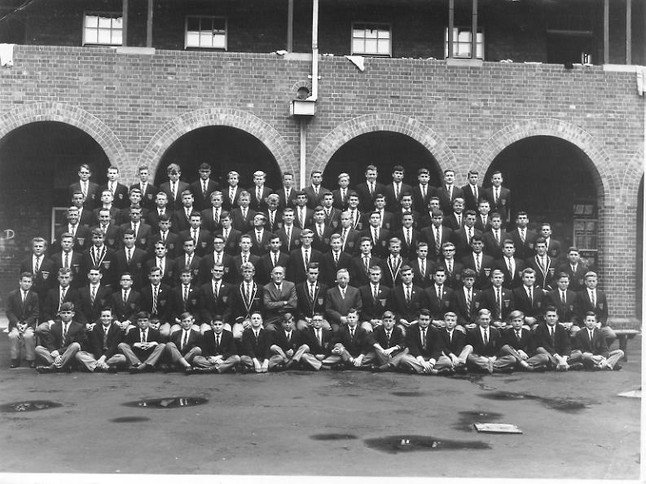
Blackmore's House - 1963
Top Row: Hilcove II, ?, ?, Wray-Brown, Hunt, Westbrook !, Murray-Brown, ?, Watson, Dickens, Francis, de Klerk, Frawley, Brouard, Champion, Westbrook II;
Second Row: Chapman, Keating, Hindle, Leisegang, Windridge, Hampson, Welfare, Tsampiras, Robert, Lynn, Chamberlain, Skelton, Chiazzari, Davidson, Tayfield;
Third Row: Pohl, Orsmond, Oldfield, Underhill, Butler, Wainman, Hancock, Schroeder, Keating, Moon, Bentley, Jordaan, Rothon, Scott, Rowley, Lane;
Standing: Robertson, Darby, Slater, Glen-Williamson, Jackson, Baker, Hilcove I, Joyce, Stern, Gold, Fitzpatrick, Jones, Remmington, Lawson, ?, Struben, Bolton, May, Mason;
Seated: Nelson-Esch, ?, Miller, Vine-Jory, Westgate, Clark I, Craig, Wraith, Mr. Charles Crewe – Head Boarder Master, van der Walt, Mr. McIver – Headmaster), van der Merwe, Wise, Waiboer, Doveton, Glaum, Nidd, Duncan, Bydawell;
Foreground: Joyner, Clark II, ?, ?, Sher, Kruger, ?, Cheyne, van der Linde, ?, de Swardt, McCall, Snyman, Goldstone, ?;
Unidentified or Misidentified: Hulley, Marshall-Smith, Wheatley, Roberts.
(Apologies for misidentifications).
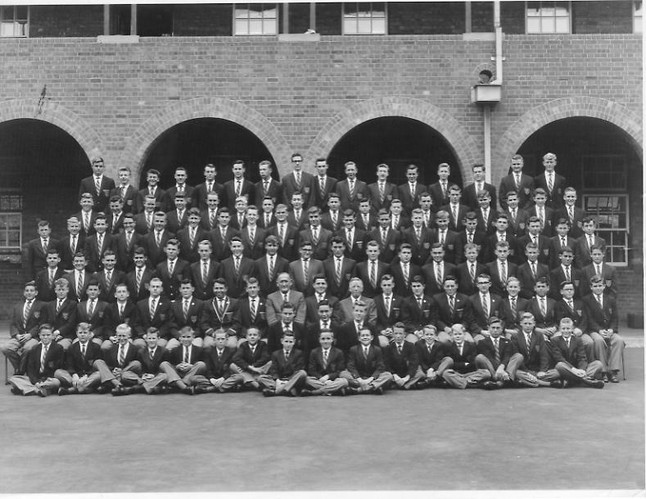
Blackmore's House - 1962
Seated: Evan Tsampiras; Randall Welfare; Dave Chamberlain; Keating; Stuart Ross-Adams; Roger Hulley; Mike Clancy; Bruce Birrell; Mr. Charlie Crewe (Housemaster); Jack Shapiro (Head Prefect); Mr. A.W. McIver (Headmaster) Alistair Wheatley; John Blakeney; P. Robert; Mike Moon; Arthur Lane; Angus Vine-Jory; ? Joyner
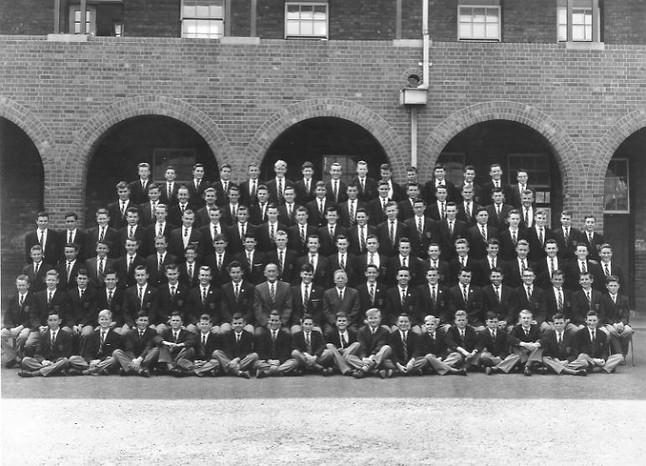
Blackmore's House - 1961
Seated: Murray-Brown; ?; John Blakeney; Warner; ?; Raymond Rogers; Peter Slater; Mike Parker; Mr. Charlie Crewe (Housemaster); Neil Lambert (Head Prefect); Mr. A.W. McIver (Headmaster); John More; Charlie Makepeace; Richard Dold; Brian Birchall; Mike Clancy; ?; Osborn; Ewan Westgate; ?
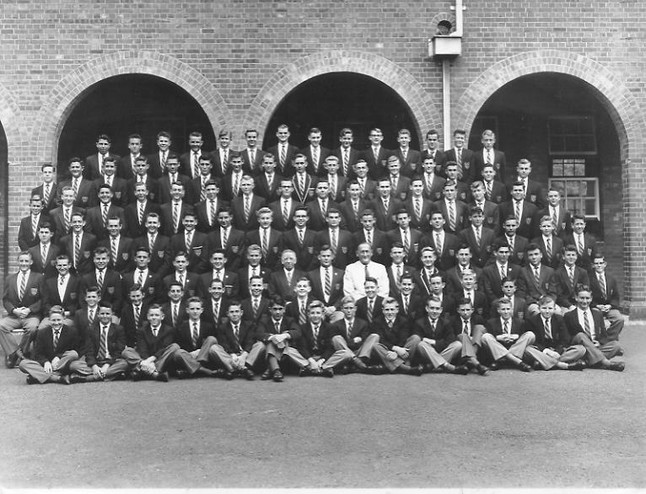
Blackmore's House - 1960
Seated: Rasmussen; ?; Mike Jones; "Arab" Dell; Clive Davies; Johnny Lansley; Rob Webber Harris; Mr. A.W. McIver (Headmaster); Ian "Animal" Wallace (Head Prefect); Mr. Charlie Crewe (Housemaster); Colin Wheatley; Vaughn Ric-Hansen; Rod Gunning; Rod Colborn; Tony Abrahams; Walker (?); Neil Whysall
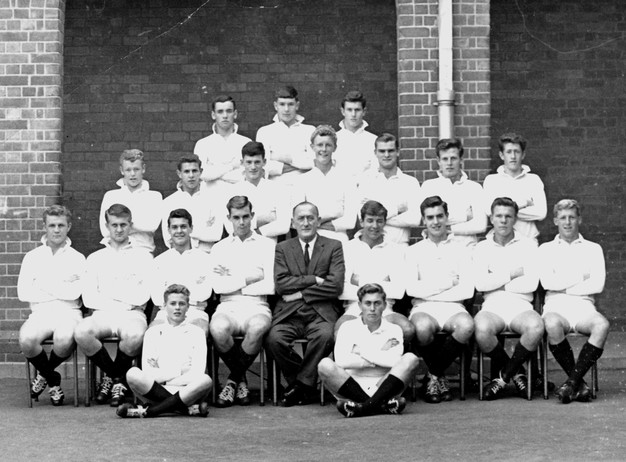
Blackmores' Rugby Team - 1963
Back: D. "Punch" Chapman, Charles Rothon, Dave Parker.
Standing: Randall Welfare, Chris Robert, Walter May, John "Eddie" Wraith, Brian Craig, Bruce Jones, Jimmy Doveton.
Seated: Bruce Robertson, Harvey van der Merwe, Bruce Lynn, Neville van der Walt, Mr. Charles Crewe, Johnny Slater, David Wise, John Darby, Steve Pohl.
Front: Peter Bydawell, Bruce Watson
All of the seated players played for the School first team, plus Eddie Wraith in the second row.
(Photo courtesy of Harvey van der Merwe)
THE LIFE OF A DHS BOARDER IN THE 1960S
While memories of friends and enjoyable events of my high school days cause me to look back fondly and with gratitude on my years at DHS, I cannot honestly say that life as a boarder is something that I look back on with particular fondness at all. The regimented, almost military, discipline and management of the boarding establishment – Blackmore’s House – made life too stressful to have been truly enjoyable. One may argue that this is necessarily how boys of that age should be treated if they are to be turned into civilized human beings with manners and respect for others, and certainly DHS generally accomplished those objectives. So if the end justifies the means, perhaps all should be forgiven.
I was a boarder at DHS from 1960 through 1963. I arrived at the school for the first time the day before the first term started in 1960, with all my worldly goods (at least from the perspective of DHS) in a tin trunk. My mother had diligently ensured that every item on the clothes list provided by the school had been purchased – right down to buying her cricket-challenged son a beautiful pair of calfskin cricket boots. Also on the list were two school blazers, two cricket shirts, two rugby jerseys (a School jersey and a white jersey for practices). All purchased from Payne Bros. on West Street, of course, since that was the official school supplier, and the only place where a DHS tie, badge, basher, or rugby jersey could be purchased (with proof of entitlement to wear those colours, of course).
My parents and I met headmaster A.W. McIver, whom my father knew from playing hockey against him in the pre-war years – though they had not seen each other since then. Mr. McIver’s first comment to my father was “Aren’t you bringing him to the wrong school?” – my father went to Glenwood, as Mr. McIver knew. But the decision that I should attend DHS was my mother’s (my mother knew the school because her mother, Kay Evens, had been the matron of Blackmore’s House when Col. A.C. Martin was headmaster, right after World War 2).
Next stop was a meeting with head boarder master, “Charlie” Crewe. I discovered that I had been assigned to “V3” dormitory,[1] and that my dormitory prefect was Johnny Lansley, whose parents owned the hotel on the beach at Westbrook, near Tongaat.
My Dad helped me lug my trunk upstairs to the V3 dormitory, where I discovered a hospital-ward style rectangular room with about ten beds placed at right angles along each of the longest walls. Between the beds each boarder had a locker with hanging space and shelves.
The first person that I met was A. N. “Nick” Bryant of Isipingo, who was to become a good friend at school and thereafter. Also assigned to my dormitory, I was later to discover, were Ewan Westgate, Keir Struben, Martin Davies, Martyn Joyce, Rens Waiboer – I can’t recall who the others were.
Waiting for the dinner bell on that first day as a boarder, while sitting on the brick terrace in front of the war memorial, and overlooking the sports fields, was one of my most miserable experiences ever, as I anticipated the unknown. I watched a solitary pupil in his rugby kit, sprinting and jogging and “tackling” the padding around the base of the rugby posts. One of the returning boarders told me that the pupil was Ian “Animal” Wallace, a tough “take no prisoners” flanker on the first rugby team, and the head boarder prefect. I flinched at the prospect of being “flogged” (i.e. caned) by him! Soon I would discover that there was good reason to flinch!
Starting from my first day the evening bell at 6.00 p.m. was the deadline for all boarders to be present in the Quad for roll call. The sixth formers lounged against the Windmill Road exterior wall of the boot room. The fifth formers lined up next, starting under the verandah outside the passage between the prefects’ room and the library entrance, and extending under the verandah opposite the V1 dormitory. The fourth formers followed, lined up under the verandah opposite dormitory V2, with the third formers following, extending to below dormitories V3 and V4. All were lined up alphabetically by form. The duty prefect then read the names of each boarder, and each answered in turn – with the absentees sometime being identified as “sick room” or absent for other reasons. Where brothers were boarders they were called by surnames and a number, for example as Clark I and Clark II.
After roll call everyone trooped into the dining room for dinner, in order of form, starting with the sixth formers. Immediately inside the entrance door was the prefects’ table. Behind the prefects’ table was a column, and behind that was the sixth formers’ table. To the right were two long tables that accommodated about 45 diners each on two sides of the table, with a prefect sitting at each end (who rotated depending on who was on duty). Think of the dining room in the Harry Potter movies to get a sense of the atmosphere. At the St. Thomas Road end of the dining room was a table on a raised platform where the boarder masters sat.
On entering the dining room the boys were required to stand behind their chairs waiting for grace. (It was a punishable offence to place your hands on the back of the chair, as it was to talk before grace.) A boarder master would then recite the Latin grace: “Benedictus benedicat per Jesum dominum nostrum” (Blessed is He and blessed is this [food] through Jesus Christ Our Lord.” – Jewish boarders were not excused the grace.) Then the master would strike a small gong, and the boys could be seated. (One evening a somewhat inebriated master struck the gong with a banana instead of the regular hammer, and it made a flat “thonk”, to the delight of the boys!)
After grace the boys were allowed to sit and the food was then served by the kitchen staff. No one was permitted to leave, however, until the gong was sounded again.
One of the features of the dining room table was that boys were permitted to bring their own supplements, such as golden syrup (although this was provided occasionally, in place of the regular melon and ginger or apricot jam), peanut butter, Marmite and Bovril, Worcester sauce, tomato sauce, etc. It is now too long ago to remember what the menu selections were, but I do recall that a regular menu items were porridge for breakfast (oats or maltabella), and Welsh rarebit for lunch – a dish that I have never eaten since DHS!
The daily weekday routine started at 6.15 a.m. when the first bell was rung. It was then permissible to get out of bed, shower, and get dressed. The second bell was at 6.30 a.m., and everyone had to be out of bed by that time. The third bell was at 6.45 a.m., and by that bell all boarders had to be seated for morning prep. Prep was conducted in various places – the sixth formers in the library, fifth formers in the room under V1, and the fourth and third formers in various classrooms leading off the Quad. At 7.15 a.m. the bell was rung to signal the end of morning prep, whereupon the boys took up their positions around the Quad for roll call and notices. Breakfast followed, after which there were a few minutes before everyone was due in the hall for the general school assembly at 8.00 a.m. (I think we first dropped off our satchels in our classrooms, then headed to assembly.
Everyone was required to bring a hymn book to assembly in the hall (now the media centre), where the boys sat by form with third formers in front and sixth formers at the back and on the balcony. Prefects stood guard at the doors, and the staff took up positions on the stage. The proceedings started with a hymn, followed by a prayer (or vice versa). Jewish boys were excused from attendance, but had to wait outside until after the Christian aspects of the assembly had been completed, after which they came in for the announcements. Headmaster McIver would make the announcements – always sports results on Mondays, otherwise general announcements. Often – especially on Mondays – Mr. McIver would express concern at the fact that a DHS boy had been seen somewhere in the neighbourhood “naked about the feet” – boys were supposed to wear shoes and socks even when out of uniform and away from the school!
At the end of the school day, the boarders returned to Blackmore’s House. However access to the dormitories was prohibited until just before supper at 6.00 p.m. Thus, unless they were playing sport, boarders were left to their own devices between the end of school (around 2.30 p.m.) until supper time. The tuck shop was a favourite haunt (though that held the risk of spending to much of the weekly allowance), as was the swimming pool. Many boys hung out in the library, or played musical instruments in the soundproof rooms in the Music Department. Others took to the rugby field to play touch rugby – the boarders version of which was wild and disorganized, as it was a free for all irrespective of age, size, or competence – a little guy like me soon discovered that ankle tapping was the only way to bring down a bigger boy at speed without breaking a body part!
As was described earlier, the supper bell was rung at 6.00 p.m., followed by dinner. Evening prep followed a 7.00 p.m. bell, and lasted until 8.30 p.m., when a further bell announced that it was time to go up to the dormitories. We had 15 minutes to get changed and get into bed by 8.45 p.m. – unless one signed up for “extra prep” in the library, in which case you were free to go to bed at any time up to 10.00 p.m.
The spectre of punishment hung like a dark cloud over the lives of boarders. The standard punishment was two “cuts” – or 200 lines for those who were willing to endure the contempt of their colleagues, which meant that even cowards like me always took cuts rather than being perceived as cowardly! The standard two cuts were imposed for a variety of offences – being late for any bell (e.g. at roll call, in prep by the start time), talking after lights out (often the entire dormitory would be “flogged” where the culprits did not own up – or the prefect falsely accused the dormitory!), leaving rugby kit or other washing on the clothes line or balcony after it was dry (as a result, in close cases we always went up and wet our clothes before the pre-prep inspection to be safe), talking during prep, being in town without school uniform or not wearing a basher, not knowing the first team members (everyone was tested at Friday evening prep), etc.
Those who had been determined to be subject to punishment were said to have been “claimed”, in the sense that a prefect “claimed” someone who was guilty of some offence. Canings (i.e. getting “flogged”) occurred after breakfast and after evening prep. The boys awaiting their canings lined up outside the door of the prefects’ room on the Quad side – sometimes a long line where a whole dormitory was up for a flogging! The procedure was that the door would be opened for each boy in turn, who approached a chair that had been placed in the middle of the room facing Essenwood Road. On the Windmill Road and Essenwood Road sides of the room there were couches where the prefects lolled, watching the events. On reaching the chair the “floggee” was required to lift the flap of his blazer (so there was no additional padding), and to bend over the back of the chair, placing his hands on the front of the seat. (If anyone was discovered with additional padding, or extra pair of underpants, additional “cuts” were prescribed after the padding had been removed – but extra padding was rarely used.) The required number of cuts were then administered by the head prefect, after which the boy thanked him and left the room by the other door. There were always a few ghoulish boys waiting in the passage outside the exit door to watch the boys emerge after their canings, and it is was a matter of honour that you did not rub your backside in the passage or hall. Most boys headed straight for the boot room, where there was the privacy needed to rub your backside and jump around to relieve the pain.
A caning always left two (or more) distinct bruises across the entire breadth of the buttocks. Often the canings broke the skin, especially if one had been unfortunate enough to be recently caned and still had a badly bruised backside! One could not imagine that kind of behavior being tolerated today. No one was spared. David Nelson Esch, a polio victim who wore calipers on both legs and walked with crutches, was frequently caned even though it was a difficult mechanical exercise for him to bend over to provide an unobstructed target!
The masters caned occasionally, normally for more serious offences like smoking (six cuts) or leaving the school premises without permission (four cuts). Housemaster “Charlie” Crewe’s cuts were compassionate, while “Dog” Perkins’ were brutal! Leslie Theobald (“Theo”) hardly ever caned, and his style was more like Mr. Crewe’s. Otherwise discipline was entirely in the hands of the prefects.
Each prefect – except the head prefect, who had his own “room” – was assigned to and occupied the corner bed of each dorm. Each prefect had two or three “fags” – third formers who would in effect act as a batman for his assigned prefect. Duties included washing sports kit, polishing shoes, performing chores (like errands to the tuck shop), running the prefects bath, and even performing some assigned duties of the prefect – most objectionably the assignment of checking the balconies for dry clothing, and thereby indirectly “claiming” those who would be caned for that offence! One dreaded seeing one of the “fags” showing up during prep with one of your garments in his hand – it meant that a caning was coming!
The fag system had its humorous side – one prefect who shall be nameless liked to send his fag to warm the lavatory seat for him in winter nights!
There was some fun too. Enjoyable activities included regular afternoon school sport and practices, using the swimming pool, “boarders only” touch rugby, use of the music room and photography rooms, use of the library, and hanging out in the tuck shop – which was then under the old science building, on the swimming pool end of the building. One could bill purchases to our parents accounts, and among the treats were small cans of condensed milk that I seem to recall cost a “tickey” (i.e. threepence, or two and a half cents after decimalization).
Boarders were permitted to go away on some weekends, from Saturday morning until Sunday evening at 6.00 p.m. It was also permitted to take a day off to go downtown, or to the beach (a Musgrave Road trolley bus or Overport trolley bus caught in Vause Road would go to the City Hall terminus, whereupon one would catch a South Beach or Marine Parade bus depending on which beach one intended to visit), or to a movie or other event. (I went to a Cliff Richard concert one Saturday afternoon, in my full school uniform and with my basher, and my basher was almost smashed by the screaming female fans!) All absences from the boarding establishment required the submission of an “Exeat” – a four line section from a standard school exercise book listing name, date, destination, and reason for absence. These had to be prepared during Friday evening prep, and they were approved and collected by a duty prefect.
If the first team was playing at the school boarders generally could not get exeats – attendance was compulsory, as it was for the day boys too (we called the day boys “reekers” – the origin of which term I do not know).
There was usually a film shown in the library for the boarders every Saturday evening during the term. One or two of the senior boys would operate the ancient projector using huge reels of film. Were saw many of the classic films of the late 1950 and early 1960s, and generally these events were popular with the boys.
Stuart Clark
Class of 1963
June 12, 2020
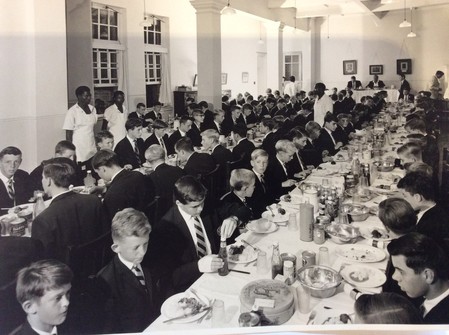
Boarders at Dinner, 1966. Note masters at the elevated table in the background.
Photo by courtesy of Graham Bell, administrator of the Class of 1964 website, and of Francois Everson and John Mason.
[1]. There is a description of the layout of the boarding establishment building in the article entitled “The Old School Building – A Description,” on the home page of this website.
Powered by Class Creator